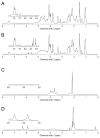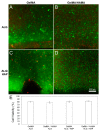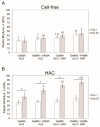A Hydrogel Model Incorporating 3D-Plotted Hydroxyapatite for Osteochondral Tissue Engineering
- PMID: 28773410
- PMCID: PMC5502978
- DOI: 10.3390/ma9040285
A Hydrogel Model Incorporating 3D-Plotted Hydroxyapatite for Osteochondral Tissue Engineering
Abstract
The concept of biphasic or multi-layered compound scaffolds has been explored within numerous studies in the context of cartilage and osteochondral regeneration. To date, no system has been identified that stands out in terms of superior chondrogenesis, osteogenesis or the formation of a zone of calcified cartilage (ZCC). Herein we present a 3D plotted scaffold, comprising an alginate and hydroxyapatite paste, cast within a photocrosslinkable hydrogel made of gelatin methacrylamide (GelMA), or GelMA with hyaluronic acid methacrylate (HAMA). We hypothesized that this combination of 3D plotting and hydrogel crosslinking would form a high fidelity, cell supporting structure that would allow localization of hydroxyapatite to the deepest regions of the structure whilst taking advantage of hydrogel photocrosslinking. We assessed this preliminary design in terms of chondrogenesis in culture with human articular chondrocytes, and verified whether the inclusion of hydroxyapatite in the form presented had any influence on the formation of the ZCC. Whilst the inclusion of HAMA resulted in a better chondrogenic outcome, the effect of HAP was limited. We overall demonstrated that formation of such compound structures is possible, providing a foundation for future work. The development of cohesive biphasic systems is highly relevant for current and future cartilage tissue engineering.
Keywords: 3D plotting; alginate; cartilage tissue engineering; chondrocyte; chondrogenesis; gelatin; hydrogel; hydroxyapatite.
Conflict of interest statement
The authors declare no conflict of interest.
Figures








Similar articles
-
Biomaterial composition and stiffness as decisive properties of 3D bioprinted constructs for type II collagen stimulation.Acta Biomater. 2022 Oct 15;152:221-234. doi: 10.1016/j.actbio.2022.08.058. Epub 2022 Aug 29. Acta Biomater. 2022. PMID: 36049623
-
Effect of gelatin source and photoinitiator type on chondrocyte redifferentiation in gelatin methacryloyl-based tissue-engineered cartilage constructs.J Mater Chem B. 2019 Mar 14;7(10):1761-1772. doi: 10.1039/c8tb02607f. Epub 2019 Jan 8. J Mater Chem B. 2019. PMID: 32254918
-
3D Printed Chitosan Composite Scaffold for Chondrocytes Differentiation.Curr Med Imaging. 2021;17(7):832-842. doi: 10.2174/1573405616666201217112939. Curr Med Imaging. 2021. PMID: 33334294
-
Protective effects of reactive functional groups on chondrocytes in photocrosslinkable hydrogel systems.Acta Biomater. 2015 Nov;27:66-76. doi: 10.1016/j.actbio.2015.08.038. Epub 2015 Aug 28. Acta Biomater. 2015. PMID: 26318806
-
Cell-laden hydrogels for osteochondral and cartilage tissue engineering.Acta Biomater. 2017 Jul 15;57:1-25. doi: 10.1016/j.actbio.2017.01.036. Epub 2017 Jan 11. Acta Biomater. 2017. PMID: 28088667 Free PMC article. Review.
Cited by
-
Heterogeneous and Composite Bioinks for 3D-Bioprinting of Complex Tissue.Biomed Mater Devices. 2025;3(1):108-126. doi: 10.1007/s44174-024-00171-7. Epub 2024 Mar 29. Biomed Mater Devices. 2025. PMID: 40028238 Free PMC article. Review.
-
Hydrogel composite scaffold repairs knee cartilage defects: a systematic review.RSC Adv. 2025 Apr 8;15(13):10337-10364. doi: 10.1039/d5ra01031d. eCollection 2025 Mar 28. RSC Adv. 2025. PMID: 40200956 Free PMC article. Review.
-
Effect of Different Additives on the Mechanical Properties of Gelatin Methacryloyl Hydrogel: A Meta-analysis.ACS Omega. 2021 Mar 26;6(13):9112-9128. doi: 10.1021/acsomega.1c00244. eCollection 2021 Apr 6. ACS Omega. 2021. PMID: 33842781 Free PMC article.
-
Tissue Engineering for the Temporomandibular Joint.Adv Healthc Mater. 2019 Jan;8(2):e1801236. doi: 10.1002/adhm.201801236. Epub 2018 Dec 17. Adv Healthc Mater. 2019. PMID: 30556348 Free PMC article. Review.
-
Development of a Photo-Crosslinking, Biodegradable GelMA/PEGDA Hydrogel for Guided Bone Regeneration Materials.Materials (Basel). 2018 Aug 3;11(8):1345. doi: 10.3390/ma11081345. Materials (Basel). 2018. PMID: 30081450 Free PMC article.
References
-
- Athanasiou K.A., Darling E.M., DuRaine G.D., Hu J.C., Reddi A.H. Articular Cartilage. CRC Press, Taylor & Francis Group; Boca Raton, FL, USA: 2013. p. 425.
LinkOut - more resources
Full Text Sources
Other Literature Sources
Miscellaneous

